Welcome to the Independence County Quilt Trail! The trail was developed by volunteer coordinator Jessica Hogue. She painted several of the blocks and had other terrific volunteers who also painted. Encyclopedia of Arkansas provides some historical information: Independence County, one of the “mother counties” of Arkansas, originally contained all or part of fifteen modern counties of Arkansas. The county’s history is tied closely to its strategic location—it sits astride the White River where it flows from the Ozark upland into the Mississippi Alluvial Plain; the river bisects the modern county from west to east. The White River bottomland is a fertile area for farming, although cotton has been largely replaced by other crops such as soybeans and rice. ” Batesville is the county seat of Independence County and has the distinction of being the second oldest municipality in Arkansas and the oldest city, with settlement starting about 1810 and the town’s plat laid out by 1821. You will want to drive through the residential area downtown and see the lovely old homes that are meticulously restored. Batesville is home to Lyon College and University of Arkansas Community College-Batesville. Other towns in Independence County include Cave City, Cushman, Newark, Southside, Magness, Moorefield, Oil Trough, Pleasant Plains, Sulphur Rock. Unincorporated communities include Bethesda, Cord, Charlotte, Desha, Floral, Rosie, Locust Grove. Enjoy your drive through Independence County looking at our quilt trail!
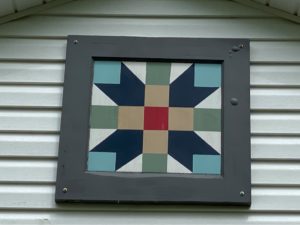
5430 Bethesda Rd.
Batesville AR
#10-1, 3-Gen Farmer’s Daughter, is located at 5430 Bethesda Rd., Batesville AR. The farmhouse at Hackberry Farm displays a 4’ x 4’ quilt block called Farmer’s Daughter. It was painted by Jessica Hogue. As a third-generation farmer, Jessica was raised on a registered Angus cattle farm. Her grandfather was an auctioneer, sale barn owner and cattleman who always had a variety of animals at his farm in neighboring Izard County. Jessica is the coordinator of the Independence County Quilt Trail but also took the time to paint a block for her parents’ farm in neighboring Izard County. You’ll see two blocks at Hackberry Farm and will get a sense of this young family’s love of living on a farm. They are happily working together and thriving as they raise a family in this rural setting located in the community of Bethesda. Encyclopedia of Arkansas: Although there were settlers in what became Bethesda (it was originally called Washington) in the early days of statehood, the community was officially established with the opening of a post office in 1888. The name of the community is believed to have been derived from the biblical Bethesda healing pool in Jerusalem, the word meaning “house of grace” or “house of mercy.” Bethesda is located along Highway 106, about three miles south-southeast of Cushman and about eight miles west-northwest of Batesville.
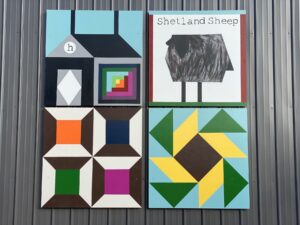
5430 Bethesda Rd.
Batesville AR
#10-2, Hackberry Farm. The barn at Hackberry Farm displays an 8’ x 8’ four patch quilt block called Hackberry Farm that represents the family’s farm life. It was painted by Jessica Hogue. The address is 5430 Bethesda Rd., Batesville AR. The farm structure on which this block hangs is accessed by a separate lane from the highway than the house where #10-1 is located. Located in Cushman, Arkansas, records show the land of Hackberry Farm was granted to Jacob Fulbright in 1906. The Fulbright family constructed the farmhouse in the 1920s. This was a time of prosper for the town of Cushman as mining of manganese ore was completed between 1849-1959. Manganese is used in the production of machinery and the mines supplied manganese used in both world wars. As demand for manganese stopped, the population of Cushman decreased. The Fulbright family moved from the area, but the land remained in the family. In 2018, Adam and Jessica Hogue purchased the home and land from the great grandchildren of Jacob Fulbright. As the farmhouse was in great disrepair, the Hogue’s remodeled and added on to the home, began a small garden, and added a flock of registered Shetland Sheep. The sheep are raised for their wool which is processed by hand on the farm. The four quilt block patches represent the family’s work on the farm: remodeling the farmhouse, bobbins of handspun yarn, garden plants for natural dyeing and Shetland sheep for wool production. You can follow Hackberry Farm on Instagram or Facebook to see pictures and stories of the family’s rural lifestyle and modern spin on the tradition of fiber arts.
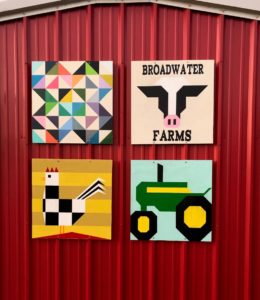
155 Hickerson Rd.
Batesville AR
#10-3, Broadwater Farms block, is at 155 Hickerson Rd. Batesville AR. A third-generation family farm is represented by the patchwork quilt block that hangs on the front of the red metal barn at Broadwater Farms. Four quilt blocks titled “Broadwater Farms” are displayed on the family farm in Bethesda. The barn quilt was designed and painted by Laura Keller. In 1965, Dale and Margaret Broadwater (grandparents of Laura) initially purchased the land in Bethesda for laying hen houses, cattle, and hay production. Dale and Margaret also owned a trucking company, Broadwater Trucking, which hauled poultry for many years. They were both an instrumental part of the early booming poultry economy for the Batesville area. Their son, Dennis Broadwater, grew up helping with the farm. He married Tracy and in 1984 they built a house on the land. Dennis and Tracy (Laura’s parents) continue to operate a commercial cattle farm on the land, as well as, harvesting their own hay. Rusty, Laura, Lainey and Rhett Keller moved to the farm in 2012 and help with the day-to-day operations. The poultry aspect has also come full circle with them as they now have Australorp chickens that free range in their back yard. In the summer months, a bountiful garden and canning takes place on the farm with the whole family involved. Broadwater Farms is truly a farm family operation with everyone pitching in to do their part.
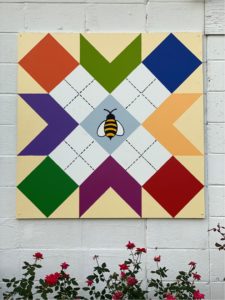
65 Lawrence Rd.
Batesville AR
#10-4, Eight Hands Round quilt block is located at 65 Lawrence Rd, Batesville AR, in the Bethesda community. It was painted by the Bethesda Quilting Bee ladies, led by Twyla Wright. The pattern is said to have been named after a square dance song that ended with “Twas from Aunt Dinah’s quilting party, I was seeing Nellie home.” The song was written in the 1850s and is performed even today. We chose this early pattern to show eight women (the 8 different colors) actively quilting. For over 40 years women have gathered in the western room of this building to hand-quilt dozens of beautiful quilts. Various women would bring their quilt tops, their batting, their liners and thread to this “Bethesda Quilting Club” for them to stitch the layers together in various quilting patterns. One of our quilters is now 90 years old and still stitching stitches and finishing the binding. We chose to place a honeybee in the center of this block because many years ago when neighbors gathered to quilt, they also visited, at times chattering until some said they sounded like humming bees. Today, we, like those before us, gather around a quilt in our “quilting bee” and share our day-to-day stories, recount our courtships, laugh our mistakes away, question our choices, and bury again our dead. Here is collective wisdom. Here we are bonded with antiquity, grounded in reality, covered with friendship. Here our spirits and fingers are one. Another reason for the “bee” in our quilt block is because our Bethesda community, dating back at least to the mid-1800s, was for a long time known for its honey. Starting in 1929, Voughn Wilson had a honey business and extracted the honey from its comb and bottled it inside a building that still stands, known as “the honey house.”
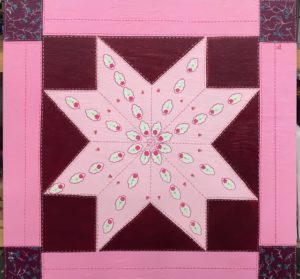
475 ONeal Rd.
Batesville AR
#10-5, O’Neal Eight Point Star at 475 Oneal Rd., Batesville was painted by Dena Shipley. The quilt from which this block was patterned was hand quilted in Harmontown, located in the White River bottoms about a mile north of the river. About ten miles west of the county seat of Batesville, Harmontown is about two and a half miles from Bethesda and about three miles from O’Neal. The quilt block is the Eight Point Star pattern and it was hand quilted by 5 Harmon ladies. There is no telling what tales were told while the tedious stiches were being sewn. The barn quilt is hung at the entrance of Harmony Hills Vineyard at 475 O’Neal Road, Batesville, AR which is the physical address, but is in Bethesda, specifically at O’Neal. Harmony Hills Vineyard has several Arkansas native Muscadine grape varieties including the Scuppernong grape. Muscadine grapes get their name from their musky aroma. Muscadines are the oldest grape in America and were cultivated by Native Americans over 400 years ago. All Muscadine grapes make wonderful jelly and are great to eat. Plus, the juice is very healthy for you. Harmony Hills Vineyard is open for picking grapes Monday through Saturday, (Sunday by appointment only), beginning in September each year. Prices vary from year to year depending on the crop. For more information you can message Mary Harmon on Facebook.
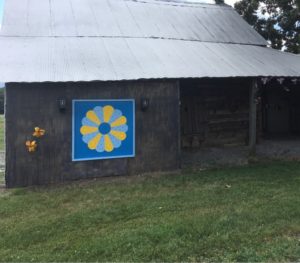
495 ONeal Rd.
Batesville AR
#10-6, Dresden Plate at 495 ONeal Rd, Batesville AR was painted by Dena Shipley. This quilt features the Dresden Plate pattern. Dena shares the story behind it: The original quilt was made by my Grandmother, Clarice Harmon, as a gift for my High School Graduation. The quilt block material was made from dresses that my mom had sewn for both of us over the years, (lots of mommy and me dresses). I picked the blue and yellow block to paint for my barn quilt because it was made from the dresses that we wore to my oldest brother’s wedding. I wore the yellow satin dress to be the flower girl for the wedding, and my mom wore the blue satin as the mother of the Groom. If you look closely you can see the little shiny flowers that I tried to replicate on the barn quilt. My brother, Mike Harmon, graduated from Batesville High School on Friday, got married to our next-door neighbor Sue Smith on Saturday, and joined the Air Force and served in Vietnam shortly after. The barn quilt is hung on a 90+ year old barn that is in O’Neal (now ONeal by the United States Post Office). The ONeal Cemetery is all that remains of a once vibrant river and railroad community. Going west on Highway 106 through Bethesda (Independence County), the ONeal Road leads to ONeal, which is about four miles from Bethesda. ONeal is about twelve miles west of Batesville. The barn is on Mary and the late Leon Harmon’s homestead. It still has the original corn crib with the original hand-hewn logs. Old family tools and many memorabilia items are in the barn that is now used as a gathering place and grandkid playhouse. The barn quilt has solar lights on each side that light it up at night. If you would like more information about how the Dresden Plate barn quilt was made please message Dena Shipley. I have step by step pictures and I would love to help you to get your barn quilt up! Let’s continue to preserve our Arkansas quilt history!

475 ONeal Rd.
Batesville AR
#10-7, Patriotic Sunbonnet Sue, is found at 475 ONeal Rd. Batesville AR. It’s actually across the road from this address but you’ll need to park while viewing #10-6 and walk across the street to get a closer look at #10-7. The owner shares, “I chose this quilt block, the Sunbonnet Sue pattern, because my name is Virginia Sue Harmon! The quilt from which it’s patterned was handmade by Clarice Harmon, my husband, Mike Harmon’s grandmother. I lived right across the road from Mike and the barn quilt now hangs on the barn where my father spent many hours putting up hay for our cows and horses. My parents moved to Bethesda, Arkansas when I was thirteen years old. When I was in High School my future husband drove his old Jalopy Model A Ford up and down ONeal road.

One day the car broke down right in the middle of the road at the end of our driveway. My friend and I thought we would fix its owner Mike Harmon up for good. At the top of the hill we put a big warning sign saying, “Caution-wreck ahead”. And we put signs all over that ole’ car. Well, our plan backfired in a way, because before you knew it Mike and I were taking his mom’s laundry to town to the laundry mat and going to the Owl show at the Melba Theater while the clothes dried. We got married just after we graduated from high school and have been married for 52 years. Mike went into the Air Force shortly after we were married. My father, Mark Smith retired from the Air Force and Mike’s father, Leon Harmon retired from the Navy, so we are a military family. The red, white and blue theme of my barn quilt is to honor all those in the past, present, and future who serve and have served to protect our great nation.” This block was painted by Dena Shipley.

380 S. 9th St.
Batesville AR
#10-8, Red Carolina Lily, is at 380 S. 9th St., Batesville AR. This “Carolina Lily” quilt block, designed and created by Professor Dustyn Bork and Lyon College art students, is an artistic representation of the Cook/Morrow quilt, part of the Old Independence Regional Museum’s quilt collection. The original quilt was handcrafted by Pernicia Dodds Cook or her daughter-in-law Ophelia Lamb Cook sometime between 1870 and 1880. V.Y. Cook, son of Pernicia and husband of Ophelia, was a prominent merchant and planter in northeast Arkansas who established the town of Olyphant then later moved to Batesville. The Cook-Morrow home, built in Batesville in 1909, still stands today at 875 East Main Street and is listed on the National Register of Historic Places. The Carolina Lily pattern was popular during the mid-19th century. The leaves are pieced and the stems appliqued. Traditional colors include red, pink or yellow flowers with green foliage. The museum houses a second quilt by Pernicia Dodds Cook from 1860 which features a Rose of Sharon pattern and uses the same blue-green material as the Carolina Lily quilt. The museum’s quilt collection encompasses over 20 recognized patterns from several eras. The quilts are made from a variety of materials, such as cotton, velvet, and synthetic materials, and range in style from plain durable everyday objects to fine works of art. In addition to quilts, the collection also includes quilt tops, wall hangings, coverlets, baby quilts and coverlets, as well as frames and clamps. Located in the foothills of the Ozarks, the Old Independence Regional Museum preserves the history of 1820 Independence County, known today as 12 separate counties: Baxter, Cleburne, Fulton, Independence, Izard, Jackson, Marion, Poinsett, Sharp, Stone, White and Woodruff. The Museum is housed in a converted National Guard armory constructed by the Works Progress Administration in 1936 and is listed on the National Register of Historic Places. Since its opening in 1998, the Museum has educated thousands. Its daily mission is to protect and present the history of these counties. Visitors are welcome at the Museum, located at 380 South Ninth Street in Batesville, AR.
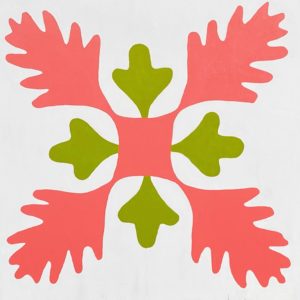
2300 Highland Rd.
Batesville AR
#10-9, Lyon Oak Leaf is on the Lyon College campus at 2300 Highland Road, Batesville AR. Note that this is the main address of Lyon College and will not lead you directly to this block which is on an unmarked street on the campus. The Grigby House log cabin where the block stands is located between the dormitories and the baseball complex toward the back side of the campus. The pattern is an “Oak Leaf” block, and the quilt it came from is in the folk-art collection of Lyon College at the Mabee Simpson Library. It has local significance and based on the appearance and condition is from at least the 1930’s and is likely from the 19th century. The Oak Leaf pattern it is based on was popularized in the mid 1840’s. Students from the Lyon College Art Program under the direction of Professor Dustyn Bork recreated the quilt on a 4 foot by 4-foot panel. It is installed on the beautiful historic Lyon College Campus in Batesville, Arkansas. Lyon College is an independent (private) liberal arts college affiliated with the Presbyterian Church. Founded in 1872, it is the oldest independent college in Arkansas. In 2019, student enrollment was 655. Lyon College has a Scottish Heritage Program that provides scholarships and hosts the Arkansas Scottish Festival every April. The program also started a campus pipe band that includes Lyon College students, faculty, and staff, along with volunteer musicians from Batesville and surrounding areas. The pipe band has performed locally in Arkansas as well as in Scotland. The Grigby House is a log house from 1867 that was moved from Bethesda to the campus. It was restored by the college and dedicated in 1983. It’s used for local history classes, provides a museum and working lab for folklore classes.
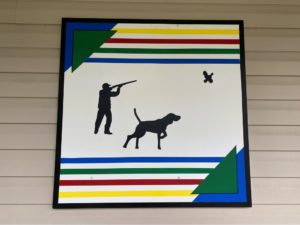
890 Bluff View Dr.
Batesville AR
#10-10, The Bird Hunter, is at 890 Bluff View Dr., Batesville AR. It was painted by Rita Rhodes. In the 1960’s when Rita’s husband was a boy, he began hunting with his dad and uncle in southern Arkansas. Wild quail were plentiful back then and getting your limit on each hunting trip was common. Although the Arkansas bobwhite quail population has dwindled over the years, Gary has never lost his passion for bird hunting. He has always owned at least two bird dogs and is partial to English setters and pointers. Their raised tails and white coloring are what make these beautiful dogs his favorite breeds. The colorful stripes on the top and bottom edges of this barn quilt are reminiscent of a favorite family blanket. The vintage Hudson Bay style wool blanket has been in Rita’s family for generations. Rita found a creative way to remember a family heirloom and her husband’s hunting passion in this quilt block rendition.
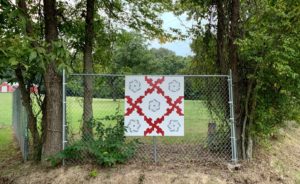
870 Rounds Rd.
Batesville AR
#10-11, Drunkard’s Path, is mounted on the fence at the start of Wolford Lane. The GPS address that works best is 870 Rounds Road, Batesville. The block is across the street from this address. This quilt block, modeled after a Drunkard’s Path quilt pieced by Myrtle Caldwell Brickell and later quilted by Kay Wolford Longenbach, can be seen on Rounds Road in Batesville. The quilt block was painted by Juli Howard, Kay’s granddaughter and Myrtle’s great-great-great granddaughter. Juli is a sophomore at Lyon College. She is a Lyon Fellows and is majoring in art and business. We appreciate Juli and her fellow art students as contributors to the Independence County Quilt Trail. We salute their creative efforts to beautify the community while preserving history with the stories that accompany their blocks.
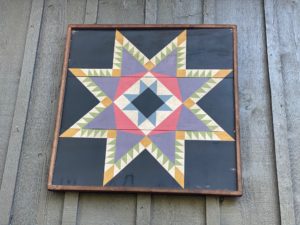
202 Vernon Dr.
Batesville AR
#10-12, The Feathered Star, is located at 202 Vernon Drive, Batesville AR. Displayed on the home of Ashley Christensen, the Feathered Star was painted by Tweedle Dee Design Co of Utah. Chosen for its intricate pattern and various colors, it represents Ashley’s love of color. Like her mother and grandmother, Ashley is gifted in pattern, colors and design for various arts such as sewing, quilting, knitting and home decorating. Her grandmother was an avid painter and seamstress, even sewing her own wedding gown. Her mother is a talented quilter and owner of The Quilted Heart in neighboring Izard County. Ashley has pieced and quilted numerous quilts for her family and friends. Her quilts are an important part of continuing our rural heritage and way of life. This story respectfully submitted by Ashley’s friend, Jessica Hogue.

650 Antioch Rd.
Cave City AR
#10-13, Wild Geese, is at 650 Antioch Rd., Cave City AR. Claire Chapman painted the block and shares the story. “I come from a family of quilters, I took a quilting class in college, and made my first quilt right after I got married. I have several quilts that are sentimental to me, gifted from grandmothers, great aunts, and my mother. As I was researching which quilt pattern to replicate and hang on our lean-to, I looked at the quilts I have, and patterns I love, but was indecisive. When the pandemic hit and left me home during a season in which I normally do not get to experience much time outdoors, I started walking our property, several times a day. I noticed that there were a flock of geese that would fly over and then settle in our field by our lean-to. At that moment I knew I needed to go with the “Wild Geese” pattern. If I hadn’t had that time at home in the spring, I would never realize the beauty blooming around me and the wildlife that share our field with us. Now, when I turn to go to 650 Antioch Road, I can remember what it was like to enjoy a slower pace of life when I could soak in God’s creation.” (Claire is a 3rd grade teacher at Sulphur Rock Elementary which is part of the Batesville School District. When’s schools closed due to the pandemic, she was home in the spring and able to appreciate the beauty of her surroundings. Her husband is a professor at Lyon College.)
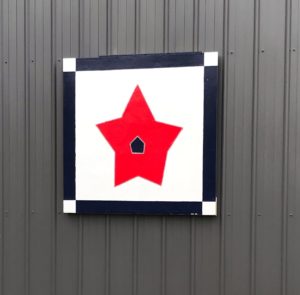
190 ONeal Rd.
Batesville AR
#10-14, Bicentennial is located at 190 ONeal Rd., Batesville AR. It was created by Kristal Allen and she shares the story: “This quilt was all hand sewn by my grandmother. She did it in 1976 since that was our countries Bicentennial. My mother and I lived with my grandparents and my job to help her was to cut the blocks out. On a lot of the quilts she made, she recycled clothes that I had grown out of or maybe something that was torn that couldn’t be repaired. She would let me help her choose the style that she would sew next, whether it be blocks or butterflies. I looked forward to the days that we would go to the fabric store to look. This is truly a dying art and I wanted to display this 44-year-old quilt, not only to remember my grandma and her love of quilting but to display our good spirit of America!”
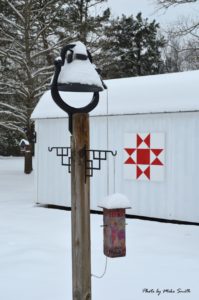
760 Reed Wade Rd.
Batesville AR
#10-15, Ohio Star, 760 Reed Wade Road, Batesville AR. (approx. 1 ½ miles east of UACCB) at the residence of Mike and Patty Smith. It is located in the back yard easily accessible from the driveway and carport breezeway. A smaller version is also hanging on the fence next to the carport. Mike shares, I chose this quilt block as a tribute to my grandmother. As a young boy I can remember my grandmother making quilt blocks and sewing them together for hours at a time until she finally had enough blocks to sew together a quilt that she would share with family and friends who were less fortunate to acquire one for their family. I can remember my grandfather setting up the quilting frame in the living room and we would all watch in excitement to see the finished product. I have traveled to other counties and even other states to take photos of awesome barn quilt block hanging on old barns and outbuilding. As a photographer I enjoy taking photos and sharing them with others of these amazing artistic abilities reflected through the barn quilt hangings. So, I thought I would try my hand at creating my own rendition of this Ohio Star Quilt block.

760 Reed Wade Rd.
Batesville AR
#10-16, Country Patriotic Flag. 760 Reed Wade Road, Batesville (approx. 1 ½ miles east of UACCB) at the residence of Mike and Patty Smith. Located on the front of Mike’s woodworking shop next to my house. Easy access driveway in front of the shop and also easy driveway to turn around in front of our house. I chose this from the original quilt block that hangs on the Stone County Veterans Affairs Office on the Stone County courthouse grounds in Mountain View, that honors the many men and women of Stone County who have served in the U. S. military. Since I am from Stone County, I take great pride in sharing my gratitude for the many who gave their lives for our great country. I thought I would share this fitting tribute to my family and friends who served.
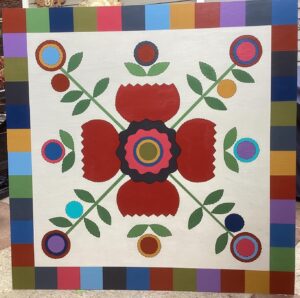
788 East Main St.
Batesville AR
#10-17, Four Patch Potpourri, is at 788 East Main St., Batesville, AR. The historic house on which it hangs was built in 1859 and was the home of Governor Eliza Baxter of Batesville for eight years. The family who owned it the longest was the Brewer family, who lived in it for 65 years, thus it was known by many of the older inhabitants of Batesville as the Brewer House. Mrs. Brewer was a seamstress and made costumes for many of the affluent people of this area. An older attorney who lived down the street said Mrs. Brewer made all his costumes and he had to “wade through thread and fabric scraps strewn on the floor throughout the house when he came for fittings.” Current owner Brenda Bolin Sandage shares, “my brothers, Mitchell and Larry Bolin, (building contractors), restored/renovated the house for me in 1986, and I have lived here ever since. The sewing studio on the south side of our lot was built by Mitchell in 2000. I have sewed for the public for over fifty years and by enlisting my husband’s help (he was the cutter) in 2020, we made over 5,000 masks at the beginning of Covid. I have done competitive sewing for many years, participating in Arkansas’ “Sew with Cotton” competition numerous times, having won the Sweepstakes six times over the years. I also participated nationally in the Threads magazine “Inspired by Threads Fashion Challenge” by Taunton Press, winning the Sweepstakes in 2002. I just love to make things, always have, and I am blessed to have a studio dedicated to “making stuff.” I have scratched the surface of just about every craft genre possible from fabric to food to decorating, but my love of fabric remains the strongest. The quilt design, Four Patch Potpourri, used as my inspiration and adapted for this barn quilt, is from my favorite designers, Kim Diehl and Laurie Baker.
These are terrific! What a neat project. Thanks for all the hard work! ❤️
I enjoyed looking and reading about all the beautiful quilts in Independence County!
I have thoroughly enjoyed seeing these quilt blocks and their stories. Jessica Hogue was a delight to work with as she took the lead to make get Independence County’s quilt blocks on the Arkansas Quilt Trail! Bravo! As Old Independence Regional Museum’s exhibit curator, I just created an explanatory panel about its “Carolina Lily” block, plus pictures of the house from which it came and its probable quilters. I then mounted a small sample of a quilt’s stitching and the “homemade” cotton batting. It is displayed for visitors to see in its entrance, and to encourage them to drive around the building to see the mounted block.
Thanks, Twyla, for your kind words. Jessica has done a fabulous job and we appreciate you spotlighting the quilt block and providing more information about it at the museum.
I enjoyed reading these stories and can’t wait to hit the trail!
Thanks, Dawn. We hope you enjoyed driving the trail.